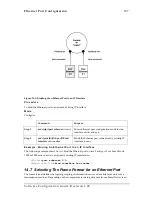
Link Scheduler Configuration
115
Software Configuration Guide, Revision 1.03
•
local-default
All other
packets that originate from the SmartNode itself.
•
default
All traffic that has not otherwise been labeled.
Action
IOS command
SmartWare command
bit rate to a source.
For IOS specifies or modifies
the bandwidth allocated for a
class belonging to a policy
map. Percent defines the
percentage of available
bandwidth to be assigned to
the class. For SmartWare
assigns the weight of the
selected source (only used
with wfq).
bandwidth
{
bandwidth-kbps
|
percent
percent
}
share
percent-of-bandwidth
Table 15-1: Command Cross Reference
15.4 Link Scheduler Configuration Task List
To configure QoS features, perform the tasks described in the following sections. Depending on your
requirements some of the tasks are required while other tasks are optional. Tasks marked with
advanced are only for administrators with sophisticated knowledge.
•
Defining the Access Control List Profile
•
Assigning Bandwidth to Traffic Classes
•
Creating a Top-Level Service Policy Profile
•
Specifying Source Classes or Lower Level Source Policy Profiles
•
Devoting the Service Policy Profile to an Interface
•
Displaying Link Arbitration Status
•
Displaying Link Scheduling Profile Information
•
Enable Statistics Gathering
15.5 Defining the Access Control List Profile
15.5.1 Packet Classification
The basis for providing any QoS lies in the ability of a network device to identify and group specific
packets. This identification process is called
packet classification
. After a packet has been classified, the
packet needs to be marked by setting designated bits in the IP header.
In SmartWare access control lists are used for packet classification. Therefore a specific service policy
has to be defined in a first step, which is used afterwards in an access control list as an optional
class
of service
(cos) group. Refer to Chapter 19, “Access Control List Configuration”, for more details
about access control lists.
Packet classification using access control lists means to define outgoing traffic that is permitted on an
interface based on the type of protocol. In combination with the optional cos group, which specifies
the priority for a certain traffic type, a very powerful packet classification method is available.
Predefined internal classes for voice and other data are:
•
local-voice
VoIP packets that originate from the SmartNode itself.
















































